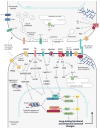Astrocyte glycogen and lactate: New insights into learning and memory mechanisms
- PMID: 29076603
- PMCID: PMC5903986
- DOI: 10.1002/glia.23250
Astrocyte glycogen and lactate: New insights into learning and memory mechanisms
Abstract
Memory, the ability to retain learned information, is necessary for survival. Thus far, molecular and cellular investigations of memory formation and storage have mainly focused on neuronal mechanisms. In addition to neurons, however, the brain comprises other types of cells and systems, including glia and vasculature. Accordingly, recent experimental work has begun to ask questions about the roles of non-neuronal cells in memory formation. These studies provide evidence that all types of glial cells (astrocytes, oligodendrocytes, and microglia) make important contributions to the processing of encoded information and storing memories. In this review, we summarize and discuss recent findings on the critical role of astrocytes as providers of energy for the long-lasting neuronal changes that are necessary for long-term memory formation. We focus on three main findings: first, the role of glucose metabolism and the learning- and activity-dependent metabolic coupling between astrocytes and neurons in the service of long-term memory formation; second, the role of astrocytic glucose metabolism in arousal, a state that contributes to the formation of very long-lasting and detailed memories; and finally, in light of the high energy demands of the brain during early development, we will discuss the possible role of astrocytic and neuronal glucose metabolisms in the formation of early-life memories. We conclude by proposing future directions and discussing the implications of these findings for brain health and disease. Astrocyte glycogenolysis and lactate play a critical role in memory formation. Emotionally salient experiences form strong memories by recruiting astrocytic β2 adrenergic receptors and astrocyte-generated lactate. Glycogenolysis and astrocyte-neuron metabolic coupling may also play critical roles in memory formation during development, when the energy requirements of brain metabolism are at their peak.
Keywords: development; emotional arousal; glia; glucose; glycogenolysis; glycolysis; metabolism.
© 2017 Wiley Periodicals, Inc.
Conflict of interest statement
The authors declare they have no conflicts of interest
Figures



Similar articles
-
Does shuttling of glycogen-derived lactate from astrocytes to neurons take place during neurotransmission and memory consolidation?J Neurosci Res. 2019 Aug;97(8):863-882. doi: 10.1002/jnr.24387. Epub 2019 Jan 22. J Neurosci Res. 2019. PMID: 30667077 Review.
-
The metabolic trinity, glucose-glycogen-lactate, links astrocytes and neurons in brain energetics, signaling, memory, and gene expression.Neurosci Lett. 2017 Jan 10;637:18-25. doi: 10.1016/j.neulet.2015.02.052. Epub 2015 Feb 25. Neurosci Lett. 2017. PMID: 25725168 Review.
-
Development of a Model to Test Whether Glycogenolysis Can Support Astrocytic Energy Demands of Na+, K+-ATPase and Glutamate-Glutamine Cycling, Sparing an Equivalent Amount of Glucose for Neurons.Adv Neurobiol. 2019;23:385-433. doi: 10.1007/978-3-030-27480-1_14. Adv Neurobiol. 2019. PMID: 31667817
-
Astrocyte-neuron lactate transport is required for long-term memory formation.Cell. 2011 Mar 4;144(5):810-23. doi: 10.1016/j.cell.2011.02.018. Cell. 2011. PMID: 21376239 Free PMC article.
-
Glycogenolysis in Cerebral Cortex During Sensory Stimulation, Acute Hypoglycemia, and Exercise: Impact on Astrocytic Energetics, Aerobic Glycolysis, and Astrocyte-Neuron Interactions.Adv Neurobiol. 2019;23:209-267. doi: 10.1007/978-3-030-27480-1_8. Adv Neurobiol. 2019. PMID: 31667811
Cited by
-
Medium-chain triglycerides may improve memory in non-demented older adults: a systematic review of randomized controlled trials.BMC Geriatr. 2022 Oct 23;22(1):817. doi: 10.1186/s12877-022-03521-6. BMC Geriatr. 2022. PMID: 36273115 Free PMC article.
-
Evolution of memory system-related genes.FEBS Open Bio. 2021 Dec;11(12):3201-3210. doi: 10.1002/2211-5463.13224. Epub 2021 Jun 28. FEBS Open Bio. 2021. PMID: 34110105 Free PMC article. Review.
-
Hippocampus-sensitive and striatum-sensitive learning one month after morphine or cocaine exposure in male rats.Pharmacol Biochem Behav. 2022 Jun;217:173392. doi: 10.1016/j.pbb.2022.173392. Epub 2022 May 2. Pharmacol Biochem Behav. 2022. PMID: 35513118 Free PMC article.
-
Sodium Butyrate Ameliorates Fluorosis-Induced Neurotoxicity by Regulating Hippocampal Glycolysis In Vivo.Biol Trace Elem Res. 2023 Nov;201(11):5230-5241. doi: 10.1007/s12011-023-03583-6. Epub 2023 Jan 30. Biol Trace Elem Res. 2023. PMID: 36710293
-
Monocarboxylate Transporter 1 May Benefit Cerebral Ischemia via Facilitating Lactate Transport From Glial Cells to Neurons.Front Neurol. 2022 Apr 25;13:781063. doi: 10.3389/fneur.2022.781063. eCollection 2022. Front Neurol. 2022. PMID: 35547368 Free PMC article. Review.
References
-
- Adamsky A, Goshen I. Astrocytes in memory function: Pioneering findings and future directions. Neuroscience 2017 - PubMed
Publication types
MeSH terms
Substances
Grants and funding
LinkOut - more resources
Full Text Sources
Other Literature Sources
Medical
Molecular Biology Databases

